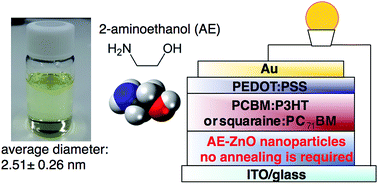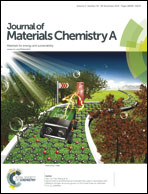Air-processed inverted organic solar cells utilizing a 2-aminoethanol-stabilized ZnO nanoparticle electron transport layer that requires no thermal annealing†
Abstract
Highly stable ZnO nanoparticles (NPs) for use in organic solar cells (OSCs) have been synthesized in 2-aminoethanol, which acts as both a stabilizing ligand and a solvent. The ZnO NP films do not require thermal annealing and applying them in inverted P3HT:mix-PCBM OSCs fabricated almost entirely under ambient conditions show efficiencies >3%. We find that thermally annealing the ZnO NP films does not give rise to any significant differences in device performance up to 150 °C. Annealing the films at higher temperatures leads to reduced short-circuit current densities and fill factors due to the removal of 2-aminoethanol from the NP surface, as evidenced by X-ray photoelectron spectroscopy. Furthermore, to confirm that the post-annealing of P3HT:PCBM devices at 150 °C does not affect our results, we fabricated inverted small molecule OSCs using a squaraine donor and PC71BM acceptor that only requires a low-temperature thermal annealing step (70 °C). No substantial differences between annealed and non-annealed devices were observed, which demonstrates the applicability of these new ZnO NPs in flexible OSCs.


 Please wait while we load your content...
Please wait while we load your content...